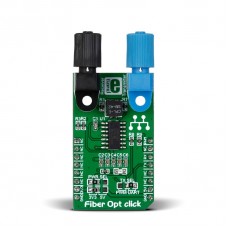Fiber Opt click
Fiber Opt click is a compact and easy solution for adding fiber-optic communication to your design. It features IF-D91 fiber-optic photodiode, IF-E97 fiber-optic LED diode as well as two operational amplifiers. Provided plastic optic connectors feature an internal micro-lens and a precision-molded PBT housing to ensure efficient optical coupling with plastic fiber cable. Data rates of up to 512 Kbps can be achieved. Fiber Opt click communicates with the target MCU via UART interface or directly through the GPIO pins depending on the position of onboard TX jumpers. UART position is set by default. Board is designed to use either 3.3V or 5V power supply.
Specification
| Type | Fiber optics |
| Applications | Board is ideal for data links, local area networks, motor controller triggering, medical instruments, EMC/EMI signal isolation and many more |
| On-board modules | IF-D91 fiber-optic photodiode |
| Key Features | Low Transmission Loss with PMMA Plastic Fiber, Interfacing through UART or GPIO pins, depending on the position of TX jumpers |
| Key Benefits | Compact design and affordable price |
| Interface | UART |
| Input Voltage | 3.3V |
| Compatibility | mikroBUS |
| Click board size | M (42.9 x 25.4 mm) |
Downloads
Features and usage notes
The combination of a fiber-optic photodiode and a fiber-optic diode constitutes a system for sending and receiving data. The configuration of components makes Fiber Opt click suitable for both analog and digital data links.
Quoting from the manufacturer's data sheet, "the IF-E97 is a high-optical-output, visible red LED housed in a “connector-less” style plastic fiber optic package. The output spectrum is produced by a GaAlAs die which peaks at 660 nm, one of the optimal transmission windows of PMMA plastic optical fiber. The device package features an internal micro-lens and a precision-molded PBT housing to ensure efficient optical coupling with standard 1000 μm core plastic fiber cable."
The optical response of the corresponding IF-D91 is from 450 to 1100 nm.
You can either transmit data using UART, or, if you switch the position of the onboard UART/GPIO jumper, you can send a PWM signal through the optical cable.
Another onboard jumper is for setting the power supply at either 3.3V or 5V.
Programming
This simple code snippe demonstrates how to set up Fiber Opt click to transmit ADC values.
1 void main()
2 {
3 char txt[20];
4 unsigned int adc_value = 0;
5
6 UART1_Init(19200); // Initialize UART module at 19200 bps
7 Delay_ms(100); // Wait for UART module to stabilize
8
9 // Every 2 seconds transmit the ADC value over Fiber Optic
10 while(1)
11 {
12 adc_value = adc_read(0);
13 IntToStr( txt, adc_value );
14 UART1_Write_Text( Ltrim( txt ) );
15 Delay_ms( 2000 );
16 }
17 }
18 }
A more elaborate example that demonstrates the use of Fiber Opt click with MikroElektronika hardware, written for mikroC, mikroBasic and mikroPascal for PIC, is available on Libstock
We also recomment the learn.mikroe.com article Going the distance with fiber opticsfor those who are looking for a deeper undestanding on how this click board works.
Enter the code in the box below:









